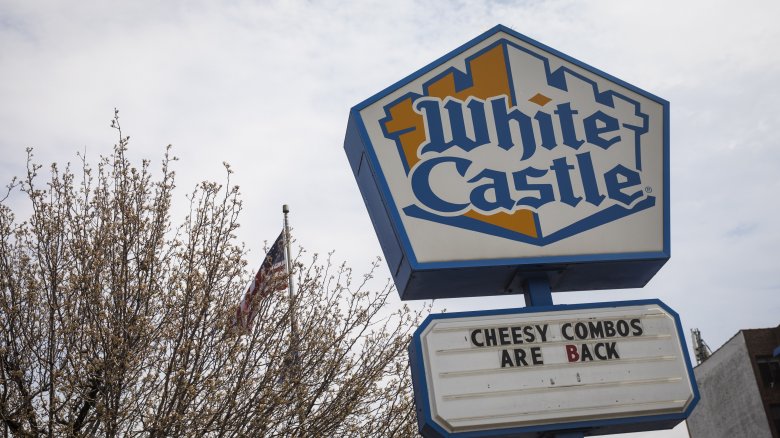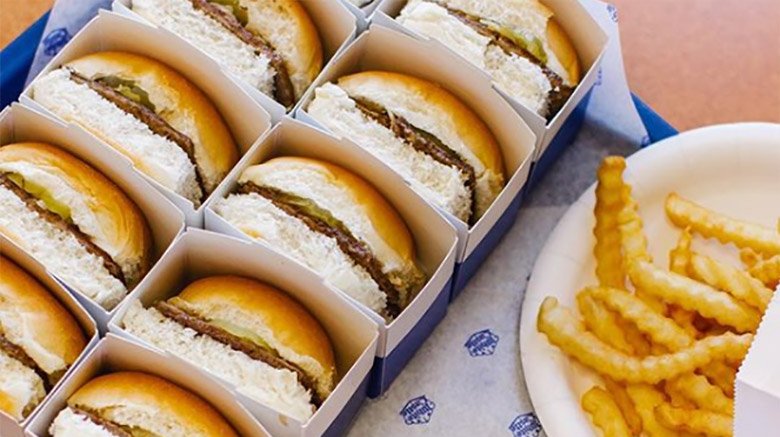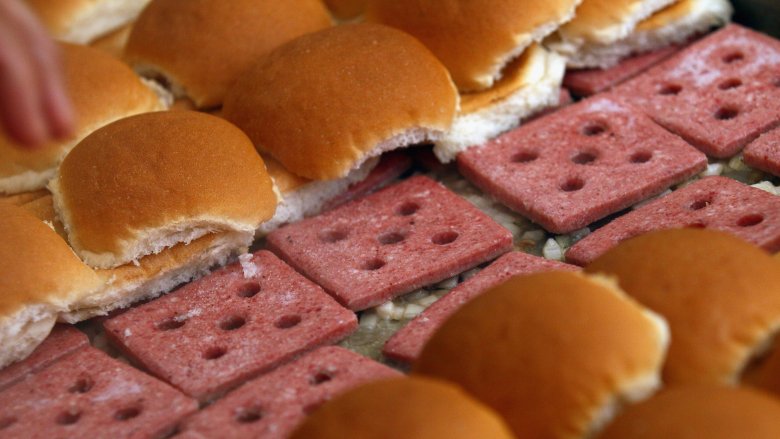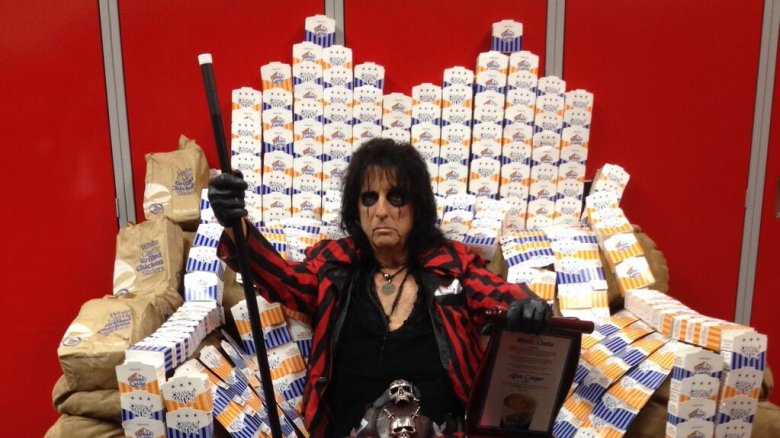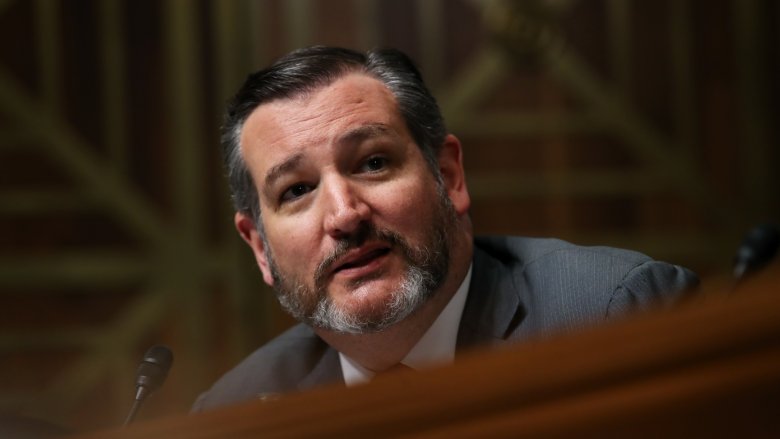The Untold Truth Of White Castle
In a sea of fast food competitors, White Castle stands out of the pack. It doesn't incorporate the food it serves into its name, it isn't named after the founder, and there is no dollar menu. Even its burger cooking process is a little strange. Yet, the company is largely responsible for giving birth to the idea of the fast food chain and helping to popularize the hamburger.
For having nearly a century of business under its belt, White Castle could certainly be one of the largest fast food chains in the United States, if not the world. That's hardly the case, however, and the company remains incredibly selective about which markets it chooses to move into.
Perhaps it's the small size of its iconic sliders, the mystique of its busy late night hours, or scarcity in certain states, but the company has been successful creating a "crave-worthy" business. Here's the lowdown on this odd little burger chain.
They became the United States' first fast food chain
There's certainly no shortage of fast food chains scattered across the United States today. From tacos to Caribbean fare and of course, plain old burgers, we have numerous choices with both national and regional fast food chains.
What might surprise you is that this fast food empire all began with lil' old White Castle back in 1921. With just $700, Edgar Waldo "Billy" Ingram and Walter Anderson opened a tiny white, castle-looking burger shack in Wichita, Kansas. The burger chain almost didn't even happen because Ingram had plans to go into the insurance business, but only decided to switch gears after meeting Anderson and being convinced that hamburgers were the way to go. It was the company's speedy service of feeding customers with sacks of five-cent hamburgers cooked to an exact specification at each location that led to the creation of fast food, according to the company's own historical records.
Perhaps even more groundbreaking than the fast food idea are White Castle's claims of popularizing the hamburger. While they can't claim that they invented the burger — that's a debate that still rages on — they did sway Americans' opinion of the sandwich.
They pushed back against claims they were unhealthy
While most of us would probably agree that hamburgers are delicious, it's a pretty big stretch to call them health food. In the first few decades of the 20th century, burgers weren't just considered an unrefined food, but downright dangerous. People looked at hamburgers as being greasy health hazards on par with eating arsenic. (Yes, it was a real insult to the hamburger.)
In order to get the misinformed public in the door and ordering his White Castle hamburgers, Ingram worked out a deal with the University of Minnesota to research the health of the food. One man volunteered to help, and eat just his burgers for 13 weeks straight.
While it might have sounded like bizarre fraternity hazing ritual, med student Bernard Flesche kept a journal of his burger and water diet, eating 20 to 24 of the small hamburgers a day. Flesche maintained good health throughout the entire 13 weeks and Ingram incorporated the study into White Castle's marketing campaign to prove customers could eat only his burgers and still maintain "physical and mental faculties." As for Flesche, well, he reportedly swore off burgers and died at 54 years old from heart problems — many years after the experiment was complete.
Cleanliness is something they're strict about
While touting the safety of White Castle hamburgers was something its founders didn't take lightly, maintaining a clean image was of equal importance. Take the name and color of the building for instance. There's a reason that it's called White Castle and not green or blue Castle.
The two men purposely decided on the color white along with porcelain countertops and stainless steel appliances because it gave the budding business a sense of cleanliness.
It wasn't just the look of the restaurant that Ingram and Anderson placed a level of sanitary scrutiny on, but the employees working behind the counter as well. Old White Castle employee checklists show that employees were to maintain a strict code of appearance. Besides the standard of cleanly washed hands and trimmed fingernails, employees were expected to be clean shaven and have their hair neatly combed and tucked under their hat. Even bad breath was a no-no.
This level of focus on cleanliness and appearance has carried over to the modern day White Castle as well. The company has not only received attention for their "fashionable" uniforms but has been one of the first fast food chains to show transparency by creating a website to display restaurant health scores online.
They refuse to sell franchises
So with all of this commitment to cleanliness and history behind it, opening a White Castle franchise seems like an awesome idea, right? Not so fast, buddy! The company likes to keep its fast food empire within the family and doesn't sell its business locations.
It's not so much that the company wants to keep its restaurants out of reach of aspiring business owners, but more about supply. The company wants to maintain "semi-localized" menu offerings and keep restaurant locations within close proximity to its supply facilities. "We try to make sure we don't complicate the operation of individual restaurants,” said Ingram's grandson, Bill Ingram. ”I think you fear a dilution of the company philosophy a little bit.”
This refusal to franchise hasn't come without a cost, of course. The company has far fewer locations compared to other burger chains like McDonald's and Wendy's and this doesn't always sit well with its fan base. Desperate fans have even go so far as launching numerous petitions, begging the company to come to their slider-free part of the country.
The company doesn't have a location in its home state
What could be considered strange and maybe even cruel in the eyes of a die-hard White Castle fan is the complete absence of a White Castle restaurant in their home state. The company was founded in Wichita, Kansas, yet you won't find a single White Castle there.
Way back in 1933, the company packed up and moved its main headquarters to Columbus, Ohio where it has remained ever since. In fact, the good people of Kansas haven't had a White Castle of their own in 80 years with the last location closing in 1938.
In celebration of their 90th anniversary — or perhaps just to taunt Kansas fans — the company did set up a pop-up shop for a single day in Wichita in 2011. "Knowing that we started in Wichita and that it is where it all began, we thought would be a great chance to bring some of the family members together," said Jamie Richardson, the company's VP. Hungry fans were able to buy sliders for 90 cents (for two) before the company packed up and left once again for the Buckeye state. Today, if a Kansan gets a craving for a fresh White Castle slider they have to take a road trip to the nearest location in Columbia, Missouri.
The burgers just aren't the same
With their ironclad commitment to the integrity of White Castle food, it's safe to assume the burgers of today are identical to what Ingram and Anderson were serving up in 1921, right? Nope.
When the company first began, the burgers were cooked by placing small balls of ground beef on a grill with a topping of diced onions. The ground beef balls were then squashed and flipped over before a bun and pickle were added. The customer then was served up a slider made with unfrozen beef — delicious.
The price has certainly changed since 1921 and over the years so did the cooking process. Today, the burgers are cooked by placing 36 frozen beef patties on a griddle over a bed of onions and water. The patties of today also have small holes punched into them thanks to a suggestion from employee Earl Howell in 1954. The company also switched from grilling to steaming their burgers, which allows for a faster cook with no need to flip.
The modern cooking process might not adhere to tradition, but rules were made to be broken and we're all getting our sliders a lot faster because of Howell's idea.
It's become popular with vegans
Unless you've been living under a rock, you know "vegan" has become a major buzz word in the food industry in the last several years. Vegan-friendly dishes might not be an uncommon addition to the menus of many sit-down restaurants, but the fast food industry has been a little slower to adapt to this growing market. White Castle isn't the first — that accolade goes to Taco Bell — but they've arguably had one of the biggest recent vegan successes in fast food.
Behold, the Impossible slider! White Castle began developing the plant-based burger with Impossible Foods back in 2017, and after 18 months had a product it was ready to send to test market. The Impossible slider began popping up on White Castle menus at 140 locations in New York, New Jersey, and Chicago, and was an instant hit. It probably didn't hurt that the company had Impossible launch parties with celebrities like Questlove and the Wu-Tang Clan.
White Castle CMO, Kim Bartley hasn't released any official sales numbers, but said the test market more than doubled its goals thanks largely to social media buzz. "I can't even tell you the multiple on social," said Bartley.
(The Impossible has now gone nationwide and speaking from personal experience, it doesn't taste identical to the original beef hamburger, but it is very good and has a nice smokey flavor.)
Harold and Kumar almost didn't go to White Castle
Now is the perfect time to segue to another group of hungry customers the company has embraced. We're talking about fans of marijuana and White Castle's time in the Hollywood spotlight with the 2004 movie Harold & Kumar Go To White Castle.
To throw a little bit of movie trivia at you, White Castle's starring role nearly didn't happen because the movie's screenwriters initially had the two friends searching for a Krispy Kreme doughnuts location to satisfy their munchies. Krispy Kreme eventually backed out of the idea and a fictional hot dog stand was swapped in place before reaching out to White Castle executives who loved the idea.
"It was like a love letter to White Castle," said Richardson, White Castle's then-director of marketing. "There was something authentic in the way the script described how people feel about our distinctive taste and the lengths they'll go to."
Slider cravings with the late night crowd don't seem to be entirely the stuff of Hollywood fiction either. According to data by Foursquare that looked at the eating habits during the prime muchie hours of 10 p.m. and 4 a.m., White Castle came out on top when compared with eight other fast food restaurants. The mobile app showed that an impressive 21 percent of the chain's business happens during that late night six-hour block.
It's a Valentine's Day hot spot
You might be shocked to learn that White Castle has a certain degree of appeal to romantics. At least as far as romantics who like to spend February 14 dining over fast food are concerned.
Nevermind that one's breath after eating hamburgers loaded with diced onions might kill any romance in the air — this hasn't stopped White Castle from marketing itself as a Valentine's Day destination for several years now. The strange thing is that it's been a major success too.
A whopping 35,000 reservations were expected for its Valentine's Day festivities at participating restaurants in 2015. In addition to waiter service and roses, the company even rolled out special menu items like bite-sized shrimp nibblers (okay, so the menu items weren't that special).
Celebrating the love between you and your significant other at White Castle obviously isn't for everybody, but for couples with a sense of humor looking to keep it casual, the idea has been a big hit.
They have a customer hall of fame
While most of us don't have the athletic prowess or musical accolades to land us a spot in a sports or music hall of fame, almost anyone can eat a hamburger. For those who have truly taken their love of burgers to the next level — specifically White Castle sliders — the White Castle Cravers Hall of Fame awaits.
Getting into this mecca of steamed burger greatness isn't an easy feat though. In fact, thousands of people have applied for admission since 2001, but just 227 have been accepted. The good thing is that anybody who feels they have a really good White Castle story or can prove their undying devotion is invited to apply, but "only a select few are committed enough to be among the elite," reads the company's website.
Each year a panel of judges comb through the thousands of entries and select up to a lucky dozen for inclusion. Among some of the more famous names who can claim membership are the creators and actors of Harold & Kumar Go to White Castle and shock rocker Alice Cooper who has loved the burgers since his childhood days in Detroit. It probably didn't hurt though that his manager is friends with the company's CEO Bill Ingram. ...The perks of being a rock star.
They were sued over the size of their booths
So here's the problem with loving White Castle — or any fast food restaurant for that matter — a little too much. If you eat there constantly, without exercising, your weight gain may get to the point where you can no longer eat inside the place you love. It's a real catch-22 and one that White Castle super-fan Martin Kessman knows all too well.
Kessman was a frequent customer of White Castle for 50 years, but the diet of sliders eventually caused him to become so overweight that he could no longer wedge himself into his local Nanuet, New York, White Castle booth. Rather than wait for his local White Castle to install bigger booths, or dare take an even more extreme approach and lose a few pounds, Kessman sued White Castle under the Americans with Disabilities Act for not providing him with six more inches of "gut space," according to Forbes.
This lack of gut space became a real problem when Kessman tried to squeeze into one of the booths and injured his knee in the process. Rather than shun White Castle burgers for good, Kessman simply had his wife pick up his slider supply. According to The New York Post, the lawsuit was eventually dropped once White Castle provided proper gut space with new seating. Hooray!
They made their own holiday
While the rise of micro-holidays filling up social media might cause some to roll their eyes, these goofy holidays do have their perks. If Krispy Kreme is going to capitalize on National Doughnut Day and Popeyes is going to play along with National Buttermilk Biscuit Day, then you can bet that White Castle is going to jump on the bandwagon for National Slider Day.
On May 15, 2019, the burger chain celebrated the holiday by offering its Cravers a free slider. All they had to do was visit their website and print off or download the free slider coupon to their phone. Of course, enjoying a slider without a cold beverage to wash it down with is just wrong, so White Castle kicked in a free soda to sweeten up the deal.
Oh, and if you're wondering where this holiday came from, because it sounds way too much like a marketing gimmick to be any sort of legit holiday, well, you're totally right. "We invented National Slider Day as a special tribute to the fans who share that appreciation for the slider and share their Cravings with us," White Castle VP Jamie Richardson, said in a press release. Ahh, that explains it.
One of the oldest White Castle locations sold for just $1
While most of today's White Castle locations are modernized with drive-thrus and are far larger than their early counterparts, there are some of those early White Castle buildings still around. The third White Castle restaurant opened in Indianapolis, Indiana in 1927 and remained in operation until 1979, making it the longest continuously operating White Castle in the country at the time. The small white brick building was even listed as a historic landmark by the National Park Service in 2011. How many burger joints can say that?
Even with its history, the building hasn't always been a hot real estate commodity and it sat vacant for 15 years after being used as a real estate office and then a National Guard Recruitment office. In 2017, Indiana Landmarks bought it from the National Guard for the price of just $1. Indiana Landmarks then put it on the market for $70,000, where it sat for two years before it was finally purchased — with a few stipulations, of course.
"Part of the agreement from purchasing it from Indiana Landmarks is that the purchaser has to restore the exterior brick," Jason Hartman, the building's new owner said. Hartman is having a special brick mason from Texas tackle the restoration job. While it probably won't become a White Castle restaurant again, Hartman is hopeful that he can find a long-term tenant that sees the value in the history of the building that only had room for five stools in its early years.
They got caught up in some political controversy with Whataburger
One of the more bizarre moments in White Castle's history involves being pulled into some political mudslinging between Texas Senator Ted Cruz, 2020 presidential candidate Beto O'Rourke, and Texas burger mainstay Whataburger. In August of 2018, when Cruz and O'Rourke were battling it out for Texas Senate supremacy, Cruz's spokesperson called his opponent a "Triple Meat Whataburger liberal who is out of touch with Texas values." Huh?
It was some pretty strange trash talking and more than a little confusing to a lot Texans who were quick to proclaim on social media just how much they enjoyed triple meat Whataburgers. It took an even more head-scratching turn when Cruz said that he was "a big fan of eating White Castle burgers." That statement wouldn't be so odd, if not for the fact that White Castle doesn't have a single restaurant in the Lone Star state. Texas writer/director Richard Linklater couldn't help but lampoon the strange political moment by making a short ad using a character from his film Bernie, who was just as befuddled by the statement as the rest of the state was.
Perhaps one day, White Castle will bestow the good people of Texas with a restaurant so Cruz and O'Rourke can hash things out over a case of sliders.
They've had their share of imitators
The saying that imitation is the sincerest form of flattery is especially prevalent if its a multi-million dollar business with a long history behind it. White Castle has had its share of imitators over the years, with most of its competition becoming just a footnote in fast food history.
White castle was dismissed as just a cheap food fad early on, but its small square burgers were such a hit that the chain found itself being imitated from competitors big and small. In the 1980s, KFC had their Chicken Littles sliders and Burger King tried its own version of the slider called the Burger Bundle.
While Chicken Littles and Burger Bundles are long gone, White Castle also saw smaller burger joints pop up that were brazen enough to rip off the White Castle name and building design. California had its own version of White Castle with the slider joint Coastal Castle. "White Castle didn't make that hamburger famous, that hamburger made White Castle famous," Coastal Castle president Kenneth H. Clifford told the Los Angeles Times in 1985. Understandably, White Castle didn't exactly agree with Clifford. "We've spent 65 years building up a reputation and we do not intend to have other people capitalize on it," Gail Turley, White Castle's director of advertising said. Long story short, Coastal Castle no longer exists.
Other imitators like White Tower, Royal Castle, and White Palace have come and gone. Meanwhile, White Castle continues to expand its Craver Nation.
